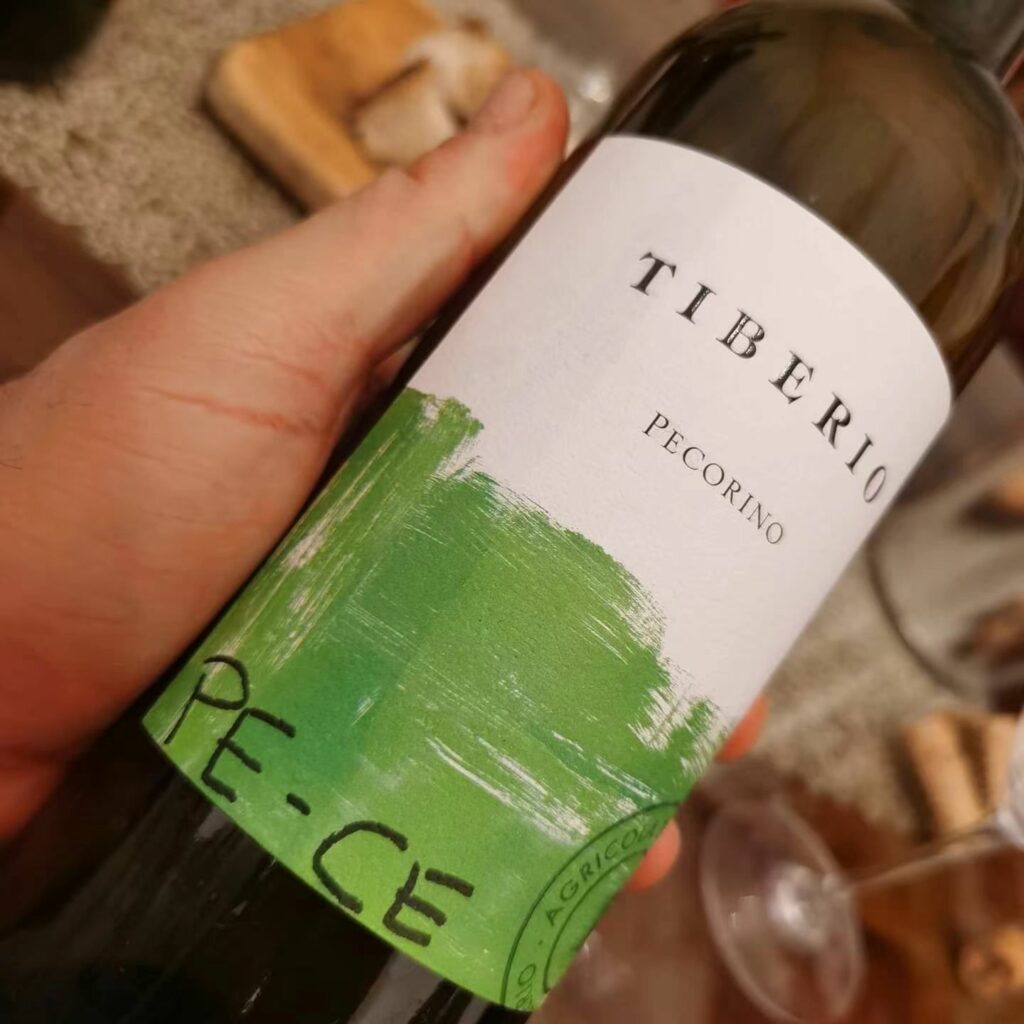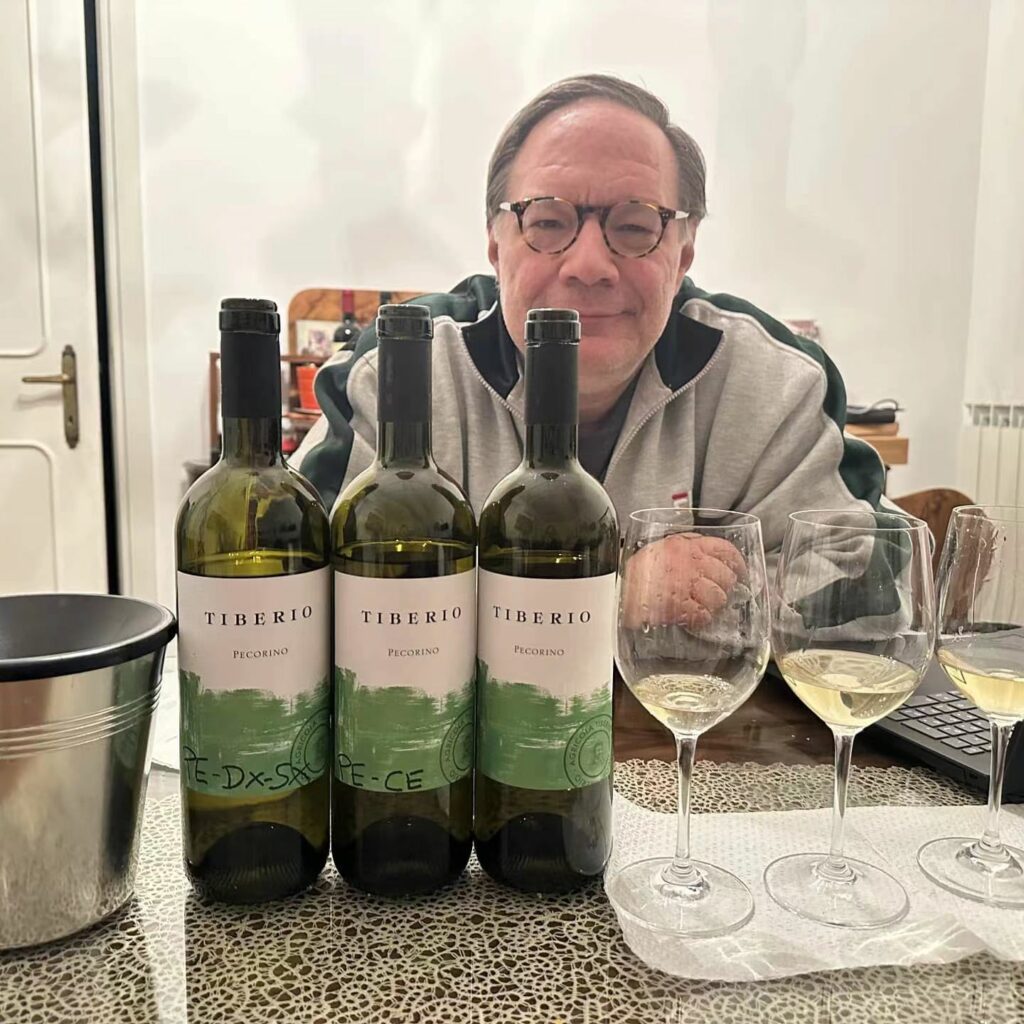Now that Cataldi Madonna’s old vines of Pecorino are recovering from serious frost episodes that hit that part of Abruzzo a few years ago, the undisputed quality leader when it comes to making Pecorino wine is the Tiberio estate located near the town of Cugnoli. Like everyone else in the region, Tiberio learned about Pecorino from the Luigi Cataldi Madonna, a noble (he’s a Baron) and philosophy university professor whom, along with the Marche’s Guido Cocci Grifoni, has done the most for the understanding and appreciation of the Pecorino grape variety, currently one of Italy’s three or four hottest. And yet, Tiberio’s wine almost never came to be.

Back in 2000, after Riccardo Tiberio had bought an old, partly abandoned estate that was to become in fifteen short years one of Italy’s leading wine lights, Pecorino was not even known to be present in the winery’s vineyards. Everyone in the family was under the impression that the estate’s land had been planted only with Abruzzo’s two staple grapes, Trebbiano Abruzzese and Montepulciano. In fact, it was the presence of the exceedingly rare former white grape that had led Tiberio to quit his job in the first place, buy the estate and set out on his own (most wineries in Abruzzo are planted to Trebbiano Toscano, Mostosa, and Bombino Bianco all of which look like Trebbiano Abruzzese but are wine quality laggards when compared to it). Valentini, who makes arguably Italy’s best wine, is famous for being among the only three-four estates that still owns, farms, and makes wine from the real McCoy, and Tiberio knew full-well what the real variety looked like, making what he had stumbled upon in Cugnoli easy to grasp. In any case, it was a chance occurrence that led to Pecorino being discovered on Tiberio’s estate grounds. One day, while walking the vineyards, his two children Antonio and Cristiana (respectively the winery’s viticulture manager and the winemaker who have since taken over the running of the winery), realized that a section of their Trebbiano Abruzzese vineyard didn’t look like it was that grape at all. Much book, ampelographic, and DNA research later, it was realized that part of the vines were actually of Pecorino and not of what they had always been thought to be. And so a star was born (over the years, the Pecorino has been the winery’s most awarded wine, though the estate’s most acclaimed and prestigious wine remains the Fonte Canale, made with Trebbiano Abruzzese, but that at only 3000 bottles a year, never gets sent to any wine shows or wine guides).
Tiberio’s unique Pecorino vineyard
Today, Tiberio’s Pecorino vineyard is 3.8 hectares large and is divided into three sections planted with different Pecorino biotypes. The central section is the oldest, planted in 2000 (but with older plants straggling along) with the Pecorino biotype called “CE” by the estate. It is also the largest (1.8 hectares) of the three sections. On the two sides of this central core, to its left and right, are planted instead the biotypes now referred to as SX (an abbreviation of left: sx, or sinistra in Italian) and DX (an abbreviation of right: dx, or destra in Italian) that were planted in the following year (in 2001). These plantings are of massal selections obtained from the central part of the vineyard, and each of the two sections is about one hectare large.
The three sections are therefore contiguous. The soil and subsoil structures of the three are essentially the same: the soil pH is about 7, and the soil can be characterized as clay-loam-sand throughout the whole vineyard extension. What really distinguishes between the three vineyard sections, besides the grape biotype, is the slope gradient, the water regimen of their soils and ambient humidity levels. (Rootstocks are also partly different and may play a diversifying role too, but that is as yet unclear.) Because these other factors of terroir are different, these differences lead to rather amazing differences in the wines made from each section (the amazing thing that is “terroir”).
The flattest of the three vineyard sections is the SX, with the slope rising through the central (CE) portion and becoming steepest in the DX part. Of note, the grapevines in all three sections are planted facing north, a somewhat surprising choice back in 2000 and 2001, but one that has proved to be a highly illuminated one.
At the base of the DX section of the vineyard runs a subterranean river. Furthermore, that is the least ventilated portion of the whole Vineyard, and is so more prone to spring frosts, such that there are years when crop levels there are very small indeed. Sunlight units are also lower than in the rest of the vineyard: this is because the DX section, while reaching the vineyard’s highest altitude (roughly 350 meters above sea level), is also the section where shadow hits first as a result of the specific topography of this section of the vineyard and the presence of nearby, surrounding hillsides and mountain tops. By contrast, the SX portion of the vineyard has a much more even and gently sloping topography, and sees sunlight from morning to late evening, leading to a more even ripening of the grapes in most vintages. The difference in altitude between the three sections is only about seven meters (still, that’s more than 25 feet) but the effects on available sunlight units and consequently on the grapes is noteworthy and in some respects, remarkable. The two grape berry parameters that end up being more affected are the thickness of the grape skin and its colour. And so it is that the SX Pecorino biotype has a much more golden-hue to its colour, while the skin of the DX biotype is more on the green side (year after year, independent of vintage). When tasting the individual grape berries, the skin of the DX biotype is thicker, crunchier and more tannic than that of the SX (again at the same stage of grape berry maturity, otherwise all I’d be writing would be moot). The DX grapes are also less aromatic than those of the SX biotype but are always loaded with a welcome, refreshing salinity. By contrast, tasting the SX biotype grapes reveals a skin that is also thick, but less than that of the DX biotype and much less thick than that of the CE biotype. It is also always the least crunchy compared to that of the other two biotypes; however, the grapes themselves are more aromatic than those of the DX biotype and slightly less so than those of the CE. The SX biotype tends to accumulate sugars faster and in larger amount than the DX, has the smallest berries of the three and is marked by the lowest levels of acidity. Its leaves are also bigger and more sagge (the latter a rare finding in Pecorino grapevines known for their smooth, remarkably circular leaf).

The CE is the historic biotype born of the five original mother plants identified back at the turn of the century by the siblings (they were actually seven original plants found, but two grapevines were too virused to be used. The CE biotype has all the classic morphologic and behavioural features of the authentic Pecorino grape variety: it’s sterile in the first basal buds (80% of which do not produce fruit: note that when Pecorino became popular, nurseries and researchers moved swiftly to correct this, such that modern Pecorino clones produce a mess of grapes, something that the original miserly Pecorino variety does not). The CE’s leaves are smaller on average and round (as previously mentioned, a highly recognizable characteristic of the Pecorino variety) with a very compact, tightly pace, elongated bunch and with small wings. Its grape juice has has much more malic acid and lower pH (2.7-3.2). The CE biotype’s yields are always lowest, both in terms of grape berry numbers, berry weight (and thus overall liquid yields). Its wine is always the sharpest and yet deepest and its fermentation is always slowest. It suffers the most in hot seasons but delivers the typical nuances of a great Pecorino wine in spades: kiwi, sage, rosemary and white fruit.
Relative to the rootstocks, Tiberio chose different ones to see what the results would be with each. The DX biotype is planted on SO4 and Kober 5BB rootstocks, generally known for having shallower rooting systems. By contrast, the SX is planted on 420 A rootstock, which pushes roots to dig much deeper.
Relative to the winemaking with each biotype, a number of interesting observations have been made over the years. Given the limited number of plants of the DX and SX biotypes, these two biotypes are currently vinified together. The DX and SX biotypes blend often suffer from blocks (stoppages) in fermentation, despite Cristiana Tiberio having tried different kinds of yeasts. From natural to semi-industrial to industrial, nothing has really worked well so far. And though many in wine simplistically think/believe that natural yeasts are the answer to everything, from making the best possible wine to curing cancer and to making dogs to speak, in fact it is not so. Pecorino has a very high natural acidity (that’s why some wineries use it to make sparkling wine) but at the same time can also develop very high alcohol and glycerol levels very quickly during fermentation when the fermenting mass is still very small and the natural yeast cell population is restricted in its number and diversity, such that it cannot bring fermentation to conclusion. And even when the yeasts do manage to, they do so while reaching very high liquid (wine) ambient temperatures making the Pecorino wine, which is normally characterized by high extract, even more textured and oily, something that Tiberio understandably neither wants nor likes (I say “understandable” given that oiliness in Pecorino wines is a fault, much as excessive diesel fuel aromas in young Riesling wines is too). Not to mention that yeasts working in conditions of stress often cause the development of off-aromas and flavours, another no-no.
The estate’s current Pecorino wine (the one that goes on sale) is a 60-40 blend, in which the DX and SX biotypes are vinified together and provide 60% of the volume, with the CE biotype making up the remaining 40%. However, it’s always the CE presence that dominates the final blend. With the 2022 vintage. Cristiana Tiberio decided to bottle 300 bottles separately of the CE and DX-SX biotype wines. Unfortunately, at the present time Tiberio cannot vinify the two DX and SX biotypes separately for lack of enough grapevines to make wine from, and for this reason she chooses to blend the must of the two, not unreasonably believing the two complement each other nicely.
The wines in this tasting
Tiberio 2022 Pecorino DX-SX biotypes blend (not for sale)

Medium deep straw yellow. Lactic, herbal and nutty nuances strongly mark the ripe yellow and white fruit on the nose. Then very broad and glyceral in the mouth, with a ripe oily quality to the ripe kiwi and custard flavours complicated by hints of mango and guava. Finishes medium-long with notes of tangerine. I’d say an 89 point wine only.
Tiberio 2022 Pecorino CE biotype (not for sale)

Now this is spectacular. Bright straw yellow, paler than the DX-SX. White peach, grapefruit, sage, kiwi, rosemary, lemon, rose water and mint on the complex nose. Then vibrant and multilayered, with sneaky concentration and utter purity to its flavours similar to the aromas. Finishes with a whiplash of acidity and amazing length. Knockout wine, I’d say 94-95 points easy and not unlike something that Dagueneau might make if he were to push ripeness levels slightly less.
Tiberio 2022 Pecorino Coline Pescaresi 94
Delightful, one of the best Pecorino wines ever made by Tiberio and that’s saying something, given they have made so many great ones. Absolutely delicious, this has the richness and size of the DX-SX and the refinement and penetrating lift of the CE. Long and lively, it’s absolutely delicious and speaks clearly of the grape: straw-green colour; lime, sage, and herbs; bright fresh and glyceral but lifted and precise on the long energetic finish. Drinking window: 2024-2030.


 中文
中文




Thank you for this enlightening and exciting post – would love to try these wines one day.
Best advice I can give you is to visit the winery, it’s an amazing visit and that part of Abruzzo is amazing, very beautiful, the town of Cugnoli charming, and there’s a bunch of really great trattorie and family-run restaurants too. It’s a shame, though of course I understand why it happens, that most wine lovers visiting Italy mostly flock to Tuscany and Piedmont, for there is so much more to see in the wine country there.
As for these biotypes and their wines, when I will next be guiding a big tasting in TO, which is something I am working on presently (shhh!) I will see about convincing/twisting Cristiana’s arm 😉 🙂 😉 🙂 to let me have them so that passionate and curious wine lovers/professionals like yourself will get a chance to taste them too and see just how different the wines from biotypes, never mind distinct grape varieties, can be.
BTW, if this topic fascinates you, then I humbly suggest you join the site tomorrow for a long article on Chinese wild grapevines, crossings and hybrids, in which I broach the subject of distinct varieties and biotypes yet again (and again, and again, and …) 🙂 Ian